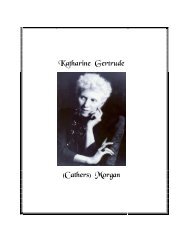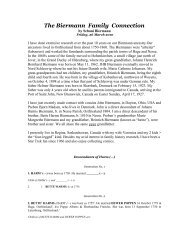A Collection of Dad's Essay's & Writings - Welcome
A Collection of Dad's Essay's & Writings - Welcome
A Collection of Dad's Essay's & Writings - Welcome
You also want an ePaper? Increase the reach of your titles
YUMPU automatically turns print PDFs into web optimized ePapers that Google loves.
Breton Flying club extricated her from the muck <strong>of</strong> the bog and the plane was dismantled and shipped back to<br />
England and apparently ended its days unheralded in Africa. It should have been preserved for posterity in a<br />
museum. If one could have created a motto for Markham it would have been “high adventure and high thinking.” She<br />
was an extraordinary personality with so many talents. Her book, “West with the Night” speaks <strong>of</strong> horses, lovers,<br />
flying Africa and her zest for life and is one <strong>of</strong> the best autobiographies <strong>of</strong> the 20th century. Her spirited short stories<br />
are as exciting as her flying adventures and her life <strong>of</strong>ten filled with “believe it or not” adventures. She is best defined<br />
in the title <strong>of</strong> her short story collection, “Splendid Outcast”. She could have lived in the cozy constraints <strong>of</strong> the<br />
Edwardian Age <strong>of</strong> a country lady in Leicestershire society. But she lived a life <strong>of</strong> rebellion and lived it in the most<br />
unorthodox fashion, became entangled with an English prince, retreated to Africa and took up flying.<br />
Etched in memory <strong>of</strong> many is the horror <strong>of</strong> a major tragedy that occurred a few days before Holger Hoiriis<br />
landed in Saint John. It was beautiful day on June 14, 1931 when two young flyers named Scotty Stirling and Rudyard<br />
Brayley took to the air in their Gypsy Moth. They had just finished enjoying some birthday cake at Brayley’s mother<br />
home to celebrate her birthday. After performing a few loops, the flyers demonstrated the Moth’s versatility by<br />
exercising a tailspin. In attempting to come out <strong>of</strong> the nosedive, the plane failed to respond and crashed onto the red<br />
rock shelving at the edge <strong>of</strong> the waters <strong>of</strong> the river a few hundred yards from the ferry landing. The wreckage was<br />
quickly removed so souvenir hunters wouldn’t have a field day.<br />
There was another less tragic event at the airport in a June that was filled with triumph, tragedy and momentous<br />
events. Two friends <strong>of</strong> Bernt Balchen, Charles St<strong>of</strong>fer and Anthony Hanzlik, came to Saint John from New York on<br />
June 19, 1931 to make arrangements for another transatlantic flight. This time it was Ruth Nicholls who would<br />
attempt what no other female had accomplished. But it was not to be! Shortly before eight o’clock in the evening <strong>of</strong><br />
June 22 Nichols’gold and white Lockheed Vega was spotted over the airport. Taking note <strong>of</strong> the L-shaped runway,<br />
Nichols brought the plane down, swooped up again to make another attempt. Her Vega touched the runway, lifted<br />
again several feet and disappeared behind the hillocks at the end <strong>of</strong> the runway. She had crashed.<br />
Nichols later said it was difficult to bring a fast plane down on a small field, and added “coupled with the fact that<br />
the sun completely blinded me.” But eye witness accounts seemed to indicate that originally she had touched down in<br />
the middle <strong>of</strong> the runway and it was a case <strong>of</strong> misjudgment on the part <strong>of</strong> the aviatrix. Ruth Nichols was assisted out<br />
<strong>of</strong> her Vega and driven to the airport <strong>of</strong>fice then rushed to the Saint John General Hospital. Nichols had cracked two<br />
vertebrae and wrenched her back. There were reports at the time that she made uncomplimentary remarks in<br />
unladylike language about the Millidgeville airport to a local reporter.<br />
This was also the day a major disaster struck Saint John, when the whole waterfront on the west side <strong>of</strong> the city<br />
disappeared in a mass <strong>of</strong> flames that began at 10:55 a.m. and consumed everything from Shed 1 to Shed 14 as well as a<br />
number <strong>of</strong> homes on Union Street and nearby thoroughfares. Meanwhile, crowds which had spent all day at the fire<br />
were jamming the roads to the Municipal Airport, once word flashed around the city about the Nichols crash. It was a<br />
slow drive out Millidge Avenue for those who owned vehicles. It was probably the worst congestion <strong>of</strong> men and<br />
machines the area had ever experienced.<br />
A week after her crash, Ruth Nicholls was born al<strong>of</strong>t on a stretcher in a plane flown by famed pilot, Clarence<br />
Chamberlin, who had piloted an aircraft across the Atlantic in 1927 with passenger Charles Levine. This was after the<br />
famed Lindbergh flight. Chamberlin flew Nichols home to Rye, New York. But it wouldn’t be the last that was heard<br />
from the noted aviatrix. After several other mishaps, one which occurred after her Saint John visit, Nichols was finally<br />
grounded a couple <strong>of</strong> years after the end <strong>of</strong> the Second World War. The curtain came down with finality and at the age<br />
<strong>of</strong> 59 she committed suicide. But her name will be remembered along with Amelia Earhart, Amy Johnson and pretty<br />
Beryl Markham, who emblazoned their names forever in the history <strong>of</strong> flying during those exciting days <strong>of</strong> the early<br />
1930’s.<br />
In 1932 another famous flyer created more excitement in Saint John. It was James Mollison, a Scot who put his<br />
Silver Puss Moth down in a farmer’s field at Pennfield Ridge, about 40 to 50 kilometers from the local airport at Saint<br />
John. He had made his first westward solo crossing in a Moth. Flying East to West was the hard way <strong>of</strong> crossing the<br />
Atlantic in those days <strong>of</strong> pioneering. Mollison’s intended destination was New York. That day the road from Pennfield<br />
to Saint John was packed solid with vehicles driven by people coming to welcome another hero <strong>of</strong> the hour. And a<br />
hero’s welcome he received. In 1936 Beryl Markham made a longer east to west flight when she left Britain. Mollison<br />
had started his flight in Ireland.<br />
The major impact on the city <strong>of</strong> Saint John was seen by the business and political disciplines <strong>of</strong> the time as<br />
putting the city on the map. Millidgeville was envisioned as a major airport with mail service, commercial service and<br />
perhaps passenger service in the future that would be <strong>of</strong> tremendous benefit to the whole area. The dream was a pipe<br />
dream.<br />
A wave <strong>of</strong> anxiety spread through Saint John on September 12, 1932, when it was reported that a twin engine<br />
Sikorsky S-38 amphibian aircraft was missing <strong>of</strong>f the coast <strong>of</strong> Greenland. The plane carried the Hutchinson family,<br />
who had only a few days before been feted by politicians, business leaders and the general public in the Loyalist City.<br />
Less than three weeks earlier the Hutchinsons had landed in Millidgeville at the seaplane base. It was to be the first<br />
leg <strong>of</strong> an historic transatlantic flight to Great Britain that would be considered momentous and have tremendous<br />
importance in the young age <strong>of</strong> flying.<br />
The idea for the event had been conceived by wealthy George Hutchinson <strong>of</strong> Baltimore, Maryland. As part <strong>of</strong> the<br />
proposal, he would take along his wife, Blanche, two daughters, Kathryn, eight and Janet Lee, six. With them were<br />
engineer Joseph Ruff, radio operator, Gerald Altifish, navigator Peter Redpath and cameraman Norman Alley. And<br />
then there was the family dog. On August 23, the family had been tendered a truly fine banquet at Saint John’s<br />
Admiral Beatty Hotel, chaired by recently elected Mayor James Brittain and attended by many dignitaries, politicians<br />
and much <strong>of</strong> the cream <strong>of</strong> the city’s social elite. Civic <strong>of</strong>ficials were all smiles when the local landing strip at<br />
Millidgeville made headlines here and elsewhere as famed pioneers <strong>of</strong> flying made stopovers. A few days prior to the







